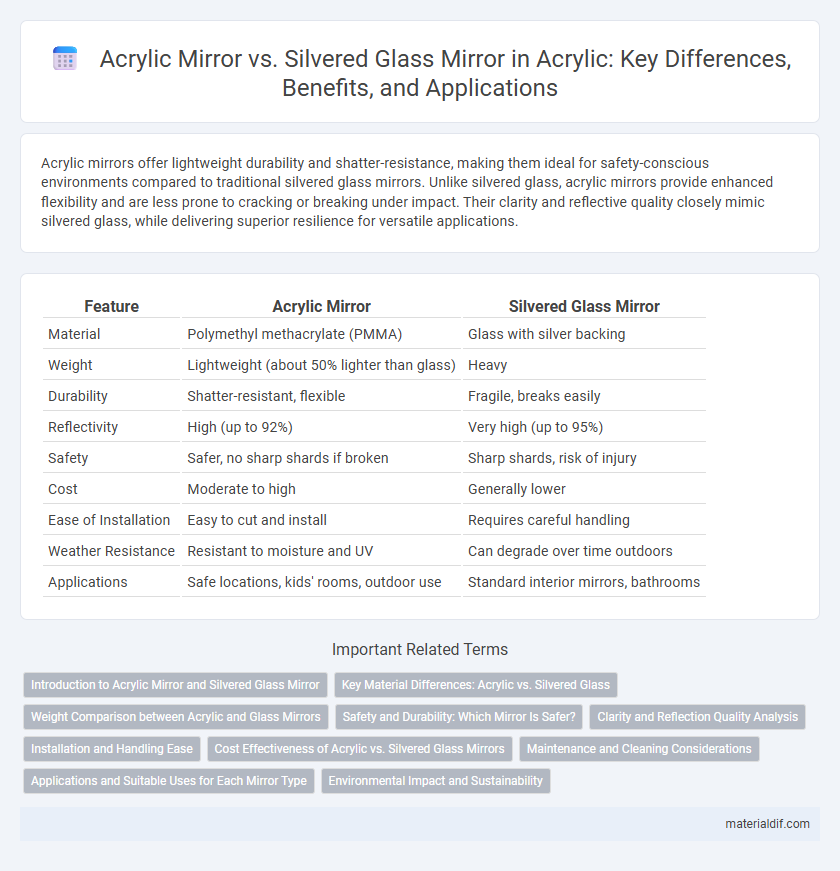Acrylic mirrors offer lightweight durability and shatter-resistance, making them ideal for safety-conscious environments compared to traditional silvered glass mirrors. Unlike silvered glass, acrylic mirrors provide enhanced flexibility and are less prone to cracking or breaking under impact. Their clarity and reflective quality closely mimic silvered glass, while delivering superior resilience for versatile applications.
Table of Comparison
| Feature | Acrylic Mirror | Silvered Glass Mirror |
|---|---|---|
| Material | Polymethyl methacrylate (PMMA) | Glass with silver backing |
| Weight | Lightweight (about 50% lighter than glass) | Heavy |
| Durability | Shatter-resistant, flexible | Fragile, breaks easily |
| Reflectivity | High (up to 92%) | Very high (up to 95%) |
| Safety | Safer, no sharp shards if broken | Sharp shards, risk of injury |
| Cost | Moderate to high | Generally lower |
| Ease of Installation | Easy to cut and install | Requires careful handling |
| Weather Resistance | Resistant to moisture and UV | Can degrade over time outdoors |
| Applications | Safe locations, kids' rooms, outdoor use | Standard interior mirrors, bathrooms |
Introduction to Acrylic Mirror and Silvered Glass Mirror
Acrylic mirrors are lightweight, shatter-resistant alternatives made from polymethyl methacrylate (PMMA), offering enhanced safety and durability compared to traditional silvered glass mirrors, which consist of a glass substrate coated with a reflective silver layer. While silvered glass mirrors provide superior optical clarity and scratch resistance, acrylic mirrors excel in impact resistance and versatility for applications requiring both safety and aesthetics. These differences influence their use in environments such as bathrooms, gyms, or children's rooms where safety is paramount versus settings demanding high-quality reflection.
Key Material Differences: Acrylic vs. Silvered Glass
Acrylic mirrors are lightweight, shatter-resistant, and offer high impact durability compared to silvered glass mirrors, which are heavier and more fragile. Acrylic material provides greater flexibility and is less prone to breakage, making it ideal for safety-focused or high-traffic environments. Silvered glass mirrors excel in optical clarity and scratch resistance due to their reflective silver coating, but their rigidity and brittleness limit versatility in certain applications.
Weight Comparison between Acrylic and Glass Mirrors
Acrylic mirrors weigh approximately 50% less than silvered glass mirrors of the same size, making them a lightweight alternative ideal for large installations and wall mounting. The reduced weight of acrylic mirrors decreases the risk of damage during handling and installation, enhancing safety and ease of use. This weight efficiency also contributes to lower shipping costs and increased versatility in design applications compared to traditional glass mirrors.
Safety and Durability: Which Mirror Is Safer?
Acrylic mirrors are safer than silvered glass mirrors due to their shatterproof and impact-resistant properties, making them ideal for environments prone to breakage. While silvered glass mirrors offer superior clarity, they are fragile and can break into sharp shards, posing safety hazards. Acrylic mirrors also provide greater durability against moisture and UV exposure, ensuring longer-lasting performance in various settings.
Clarity and Reflection Quality Analysis
Acrylic mirrors offer high impact resistance with clarity levels close to glass but typically exhibit slightly lower reflection quality compared to silvered glass mirrors. Silvered glass mirrors provide superior optical clarity and true-to-life reflection due to the high-quality silver coating, resulting in minimal distortion and enhanced image sharpness. Acrylic mirrors are more lightweight and shatter-resistant but may develop minor surface scratches that can affect reflection precision over time, unlike the durable surface of silvered glass.
Installation and Handling Ease
Acrylic mirrors offer superior installation and handling ease compared to silvered glass mirrors due to their lightweight and shatter-resistant properties, reducing the risk of injury and damage during setup. Their flexibility allows for easier cutting and fitting into unconventional spaces, making them ideal for DIY projects and custom installations. Silvered glass mirrors require careful handling and professional installation to avoid breakage, making acrylic a more practical choice for fast, safe, and efficient mounting.
Cost Effectiveness of Acrylic vs. Silvered Glass Mirrors
Acrylic mirrors offer significant cost savings compared to silvered glass mirrors due to lower material and manufacturing expenses. These lightweight mirrors reduce shipping and installation costs, making them ideal for budget-conscious projects. Additionally, acrylic mirrors are less prone to breakage, decreasing replacement and maintenance costs over time.
Maintenance and Cleaning Considerations
Acrylic mirrors require gentle cleaning with non-abrasive, ammonia-free solutions to prevent scratching and maintain clarity, whereas silvered glass mirrors tolerate standard glass cleaners but can suffer from moisture damage if the backing is compromised. Acrylic's lightweight and shatter-resistant properties reduce the need for frequent handling, lowering the risk of damage during maintenance. Regular dusting and using a microfiber cloth are essential for both mirrors to preserve surface integrity and reflectivity.
Applications and Suitable Uses for Each Mirror Type
Acrylic mirrors are ideal for environments requiring lightweight, shatter-resistant surfaces, such as gyms, children's rooms, and outdoor installations. Silvered glass mirrors offer superior optical clarity and scratch resistance, making them suitable for high-end bathrooms, makeup mirrors, and decorative wall art. Choosing between acrylic and silvered glass mirrors depends on balancing durability needs with image fidelity requirements in specific applications.
Environmental Impact and Sustainability
Acrylic mirrors offer a lower environmental impact than silvered glass mirrors due to their lightweight nature and reduced energy consumption during manufacturing. Unlike silvered glass, acrylic is recyclable and generates less waste, reducing landfill burden and promoting circular economy principles. The durability and shatter-resistance of acrylic mirrors extend their lifespan, minimizing frequent replacements and conserving natural resources.
Acrylic Mirror vs Silvered Glass Mirror Infographic

 materialdif.com
materialdif.com